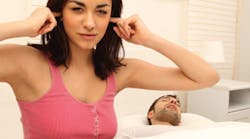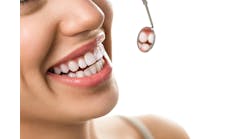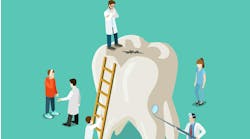Dentist Finds Investment In Time And Practice Well Worth It
by Erin E. Elliott, DDS
It’s another gorgeous day in North Idaho, and my schedule is packed with restorative dentistry and hygiene checks. On today’s schedule is one of my favorite patients, Shawn. I usually see him only every six months, and I’m always prepared to exchange jokes with him. I have a good one for this visit, but thankfully I’m not seeing his daughters today. I usually have to do a really bad cartwheel for them in the waiting room. All three are amazing gymnasts, and after I told them that I got kicked out of gymnastics because I couldn’t figure out how to do a cartwheel, they made me prove it by showing them my cartwheel.
In addition to his three teenage daughters, Shawn has a wonderful wife and a great job. He travels often, but he’s wondering why he feels more and more rundown. When I checked Shawn during his routine six-month visit, I asked about his girls, wife, job, how he was feeling, and finally how his teeth were. Of course he said they were fine; they’re always fine. Shawn is a healthy, middle-aged Caucasian male with a clean health history. Certainly he has no problem. Does this sound familiar?
Ever since I finished my training to treat sleep apnea, I’ve been looking at teeth, tongues, and throats completely differently. What I noticed about Shawn that I hadn’t before was that his teeth had erosion, he had a large scalloped tongue, and he had a constricted mandible. But he was thin and tall with a small neck, not a stereotypical sleep apnea patient. I figured there was no way he had sleep apnea. His medical doctors didn’t mention it. Certainly there was nothing to pursue. Or was there?
Shawn saw that I had a poster in my waiting room about snoring and sleep apnea, so he mentioned that he’d been having trouble feeling rested and that he felt rundown. Also, he falls asleep immediately when the plane takes off on his business trips. Shawn was wondering if it’s because he snores at night. However, he’s getting older, he works hard, and he has teenage daughters. Why wouldn’t he be getting tired? We think, certainly there’s no problem; he’s just getting older.
What To Ask Yourself At The Next Recall Exam: | ||
Signs of hypoxic distress | Signs of airway distress | Signs of dental distress |
• Fatigue | • Vaulted arched palate | • “Turkey waddle” |
• High blood pressure | • Narrow arch | • Overbite |
• Poor concentration | • Large neck | • Bruxism |
• Bags under the eyes | • “Uvula engorgement” | • Erosion |
• Snoring | • Mouth breathing | • Scalloped tongue |
I contemplated all this a bit further. His wife says his snoring is getting worse, that he complains about fatigue, and I find signs in his oral cavity that suggest sleep apnea. I recommended that he get a sleep study done. I don’t do sleep studies because I’m not a physician, but I can become a health-care partner. An oral appliance is a dental solution for sleep apnea, but sleep apnea is a medical problem that requires a medical diagnosis. Oral appliances help open a closing airway (and serendipitously help snoring), which is called obstructive sleep apnea. Some with sleep apnea have breathing disorders that are unable to be treated by an oral appliance.
We see many patients in my office, and we have almost the same routine for every exam. We’re supposed to check the medical history, the throat and jaw for soft tissue abnormalities, under the tongue and cheeks for oral cancer, and finally the bone levels, gums, and teeth. What about the airway? We’re most certainly right there looking at it, but do we ever pause and wonder? If we do, we may discover one of the 400 undiagnosed sleep apnea patients currently in our practice. There are approximately 2,000 patients in a modest dental practice, and about 20% of those have undiagnosed sleep apnea. These patients go undiagnosed because, like Shawn, we don’t believe there can be a problem.
There are some hurdles. The uneducated patient may resist a sleep study and may tell you to “just treat my snoring.” But without a sleep study to know exactly what is going on, we may be creating a “silent apneic,” which is a patient that does not snore at night, but his or her oxygen levels are dangerously low. Fortunately, we have sleep studies to address these unknowns, and home sleep studies are becoming more common, and this helps address patient compliance issues.
Thankfully, Shawn accepted my recommendation and had a home sleep study performed that was read and diagnosed by a local sleep physician. I counted down the days to his sleep apnea consult. What were his results? The results came by fax and I read the diagnosis. Shawn was in fact one of the 20% of undiagnosed sleep apneics in my practice. In fact, he had moderate sleep apnea in which he stopped breathing for 10 seconds or more 79 times a night, and subconsciously tried to wake himself up to breathe better 57 times a night. No wonder he was tired!
After receiving his oral appliance, Shawn returned for his one-week follow-up with his wife. Almost immediately she said, “I can sleep with him in the same room again!” Shawn proclaimed, “I’ve stopped falling asleep on the plane when I travel for my job. I’m so much more productive.” Shawn couldn’t stop thanking me, and his wife and kids couldn’t stop thanking me. I love changing lives!
There are potentially 400 undiagnosed people in your practice. Dentists are on the front line. The medical doctors need us. They are farther downstream than we are. Shawn admitted he never would have gone to the doctor for his complaint, and he goes to the doctor only when he’s sick. Even at his biannual checkup the doctor didn’t ask about his sleep, and I bet he didn’t tell a joke, either. Because we know our patients and their families and see them often, we can help them breathe better by asking ourselves and our patients a few simple questions. Sleep apnea was difficult to catch in Shawn, but he’s just the tip of the iceberg. Next time I’ll discuss how to screen children and teenagers. This is just the beginning!
Erin E. Elliott, DDS, is a partner at Post Falls Family Dental Center and Sleep Better Northwest in Post Falls, ID, where she practices family dentistry. She has a special interest in screening and treating people with sleep apnea and snoring. She’s a member of the American Dental Association, American Academy of Sleep Medicine, and the American Academy of Dental Sleep Medicine. You can reach her at [email protected] or find more information at www.sleepbetternw.com.
Past DE Issues







